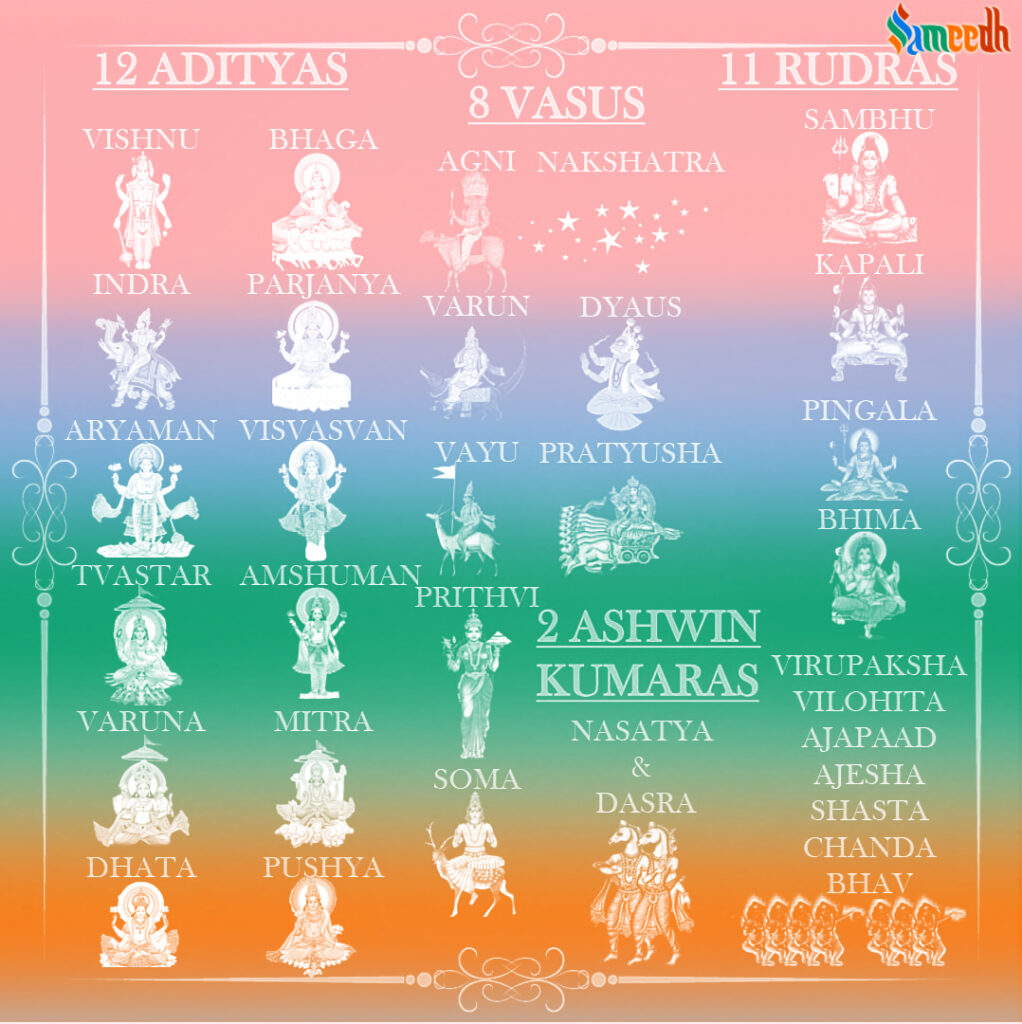In Hinduism, the concept of the “33 Koti” gods and goddesses refers to the idea of various categories of divine beings rather than a specific list of 33 deities. These categories can encompass Gods, Goddesses, Celestial beings and other supernatural entities. The phrase “33 Koti” is often misinterpreted in the context of Hinduism. The term “Koti” in Sanskrit can mean “type” or “category” rather than just “crore” (which refers to ten million).

Hinduism is a diverse religion with a vast pantheon of deities. The number and nature of these deities vary among different sects and traditions within Hinduism. In Hinduism, the term “deva” (also spelled “dev,” “devi,” or “devata”) refers to a deity or divine being. The term is derived from the Sanskrit word “deva,” which means “shining one” or “god.” Devas are often depicted as superhuman beings with powers and abilities beyond those of mortals. They are usually depicted as having a divine or supernatural origin and are worshipped as objects of reverence and devotion.
The phrase “33 Koti” is often misinterpreted in the context of Hinduism. The confusion between “33 Koti” and “33 Crores” in Hinduism arises from a misunderstanding of the term “Koti.” The term “Koti” is used in different ways in the Indian context, and its translation into English as “Crore” has led to the confusion. “Crore” is a term used to represent ten million in the Indian numbering system. However, in the context of “33 Koti” gods and goddesses, “Koti” refers to categories or types, not a numerical value.
The concept of the “33 Koti” gods and goddesses refers to the idea of various categories of divine beings rather than a specific list of 33 deities. The term “Koti” is often misunderstood to mean “crore,” but in this context, it actually means “types” or “categories.” The confusion between “33 Koti” and “33 Crores” in Hinduism is a result of linguistic and translational challenges, as well as cultural and historical factors.
Each category includes various deities, celestial beings, and manifestations of the divine.
The divine koti’s are :
- Vasus (8): The Vasus are a group of eight deities associated with various aspects of nature and elements. They are often considered benevolent and are connected with concepts like water, fire, earth, and the like.
- Adityas (12): The Adityas are a group of solar deities, often associated with the twelve months of the year. They are considered the offspring of the goddess Aditi and are sometimes identified with different aspects of the Sun.
- Rudras (11): The Rudras are a group of fierce and sometimes destructive deities associated with Lord Shiva. In later Hinduism, they are often equated with the various aspects of Lord Shiva’s manifestations.
- Ashwini Kumaras (2): The Ashwini Kumaras, also known as the Ashwins, are divine twin brothers who are considered physicians of the gods. They are often associated with healing and are known for their swiftness and beauty.
The concept of “33 Koti” is symbolic and reflects the diverse and multifaceted nature of divinity in Hinduism, allowing for a wide array of deities and beings to be revered and worshipped.
Significance and Symbolism
Each of these 33 categories holds profound symbolic meaning:
- Adityas represent the cyclical nature of time and cosmic order (Rta).
- Rudras embody transformation, inner strength, and control over emotions.
- Vasus symbolize the elemental building blocks of the universe, reflecting the unity of the physical and spiritual worlds.
- Ashwini Kumars highlight the healing power of nature and divine intervention in human well-being.
These divine forces illustrate how the universe is an interconnected system of time, nature, and human existence, guided by cosmic principles.
In the ancient Indian literature, including the Vedas and Puranas, various numbers are used symbolically to represent vastness or infinity. The number 33 is not meant to be taken literally, but rather to symbolize the countless divine manifestations and aspects that are revered in Hinduism. These manifestations can include major deities like Brahma, Vishnu, Shiv, and Devi, as well as minor deities, celestial beings, and personifications of various aspects of life and the cosmos.
The deeper meaning of the 33 Koti gods lies in their connection to the universal forces that sustain life. Rather than seeing them as 330 million individual gods, the Vedic seers emphasized the idea that the Divine is one Supreme Consciousness (Brahman) manifesting in multiple forms. The 33 categories symbolize different facets of this one Reality, much like sunlight splitting into a rainbow of colors.
This understanding encourages devotees to recognize the divine presence in every aspect of nature, time, and inner consciousness. It also aligns with the Hindu philosophy of “Ekam Sat Vipra Bahudha Vadanti” — “Truth is one, but the wise call it by many names.”
The concept of 33 Koti gods reflects the profound Vedic understanding of cosmic forces and divine energies that regulate the universe. It does not imply the existence of 330 million individual deities but rather emphasizes 33 classes of divine forces that are integral to the balance of nature, human well-being, and cosmic order. Recognizing this distinction sheds light on Hinduism’s rich spiritual philosophy and its holistic view of divinity as a unified, all-encompassing presence.